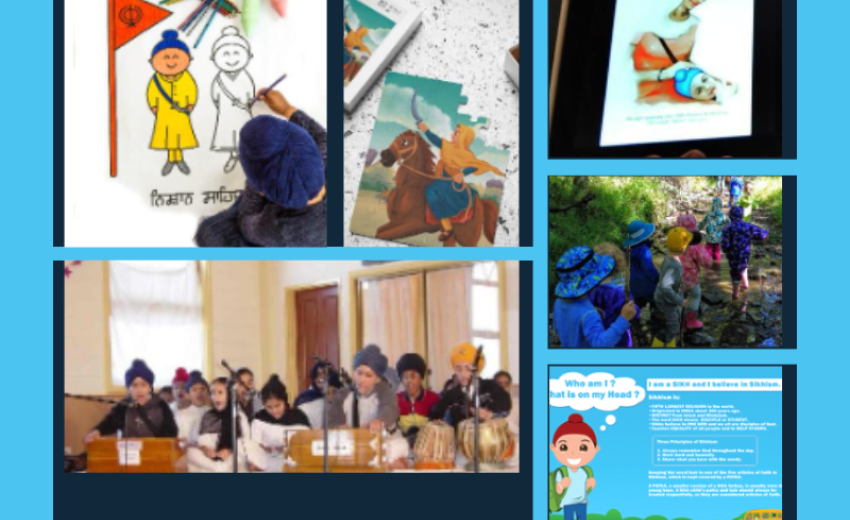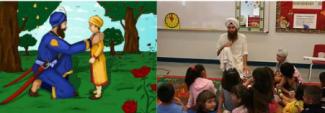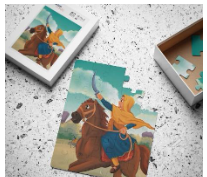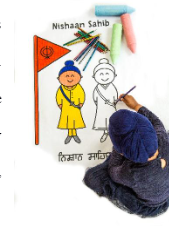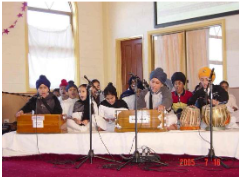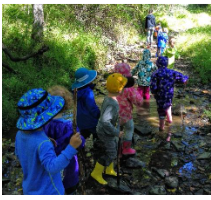Sikhism, a vibrant and inclusive religion, provides a rich tapestry of teachings and traditions. Introducing children to Sikhi through interactive learning and play not only enhances their understanding but also fosters a deep connection with the values and principles of Sikhism [1-3]. This holistic approach engages children actively, making the learning journey enjoyable, memorable, and impactful. Given the dire need for engaging in such a holistic approach, various such activities, along with their specific examples, are described hereafter.
Interactive Storytelling and Role-Playing: Sikhi has inspiring stories and parables that carry profound messages. Utilizing interactive storytelling sessions allows children to immerse themselves in the teachings of Sikh Gurus. Afterward, encouraging role-playing activities based on these stories enables them to embody their learned principles and values. This hands-on approach enhances comprehension and instills a sense of empathy and understanding [4-5]. Example: After sharing the story of Bhagat Puran Singh’s compassionate encounters with challenged and destitute people, children can engage in role-playing, where they take on the roles of Bhagat Ji and the challenged or destitute, exploring the importance of compassion, empathy, and selfless service.
Educational Games and Puzzles: Sikhi-themed board games and puzzles can transform learning into an exciting adventure. Creating games that revolve around Sikh history, symbols, and values enables children to reinforce their knowledge enjoyably and interactively [6]. Such games promote cognitive development and instill a sense of pride and curiosity about their heritage. Example: Design a board game where players navigate through historical events, answer questions about Sikh Gurus, and collect symbols like the Khanda. This game could incorporate challenges that reflect the core principles of Sikhi, reinforcing the importance of compassion, humility, and selfless service to others.
Crafting and Art Activities: Expressing creativity through Sikh-themed arts and crafts provides a tangible connection to Sikh culture [6]. Children can create turbans, design miniature Gurdwaras, or craft symbols like the Ik Onkar. These activities enhance artistic skills and serve as visual reminders of Sikh values. Example: Organize a crafting session where children create miniature Ek Onkar symbols using various materials. This hands-on activity reinforces the significance of the Ik Onkar and serves as a personal, visual representation of Sikh beliefs.
Sikhism Quiz and Trivia Competitions: Making learning competitive through quizzes and trivia competitions adds an element of excitement.
Sikhism-themed quizzes can cover various topics, including historical events, Sikh Gurus, and cultural practices. This approach encourages friendly competition and motivates children to explore Sikhism in-depth [7-8]. Example: Host a Sikhism trivia competition with questions ranging from the life stories of Sikh Gurus to the significance of crucial Sikh festivals. Incorporate multimedia elements to make the competition visually engaging and interactive.
Gurbani Singing and Music Activities: Gurbani, the sacred hymns of Sikhism, carry a musical and spiritual essence. Engaging children in interactive singing sessions allows them to connect with Gurbani through music. Incorporate simple musical instruments or rhythmic activities to make the experience lively and memorable. Example: Arrange singing sessions where children learn and sing Shabads (hymns) from the Guru Granth Sahib. Encourage them to express their creativity through music, fostering a deeper appreciation for Gurbani.
Digital Learning Platforms: Leverage educational apps and online platforms for Sikh children. These platforms often feature interactive lessons, animated videos, and games catering to young learners. Digital media can be especially effective in reaching children in diverse settings [9-10]. Example: Introduce children to an interactive app that explores Sikh history or principles through animated stories and quizzes. This digital learning experience can complement traditional teaching methods, providing a dynamic and engaging platform for exploration.
Outdoor Exploration: Nature walks and outdoor activities can be incorporated into Sikh learning. Combine these experiences with interactive elements like scavenger hunts or guided tours of local Gurdwaras. Outdoor exploration connects children with the environment and reinforces the connection between nature and Sikh values. Example: Organize a nature walk where children explore elements of nature mentioned in Sikh teachings. Create a scavenger hunt checklist that includes items representing virtues like compassion, humility, and equality.
Story-Based Mobile Apps: Explore story-based mobile apps that narrate Sikh stories with interactive features [10]. These apps can engage children with vibrant visuals, interactive characters, and quizzes, enhancing their understanding of Sikh history and principles. Example: Introduce children to a mobile app that tells the story of Banda Singh Bahadur through animated characters. Include interactive elements where children can make decisions that impact the storyline, providing an immersive and participatory experience.
Integrating interactive learning and play into Sikh education for children offers a dynamic and engaging approach that goes beyond traditional methods. By weaving the rich tapestry of Sikhism into activities that stimulate creativity, critical thinking, and active participation, we create an environment where children learn about their faith and develop a profound connection with its principles. Through interactive learning and play, Sikhi becomes a living, vibrant experience that shapes the hearts and minds of the younger generation, fostering a sense of pride and understanding in their cultural and spiritual heritage.
References
- Singh, D. P. (2024, Jan. 12). Embracing Sikhism - A Path to Harmony and Virtue for Children. Retrieved from https://www.sikhnet.com/news/embracing-sikhism
- Singh, D.P. (2024, Jan. 1). Inspiring Young People to Embrace Sikhism. The Sikh Review, Kolkata, India. 72(1). 51-55
- Singh, D. P. (2024, Feb. 4). Inspiring children to embrace a purposeful way of life. Retrieved from https://asiasamachar.com/2024/02/04/inspiring-children-to-embrace-a-purp...
- Gramlich, J. A. (2014). Talk, play, and read with me Mommy: Interactive activities to enhance your child's language development from birth to age five. AuthorHouse.
- Corradini, A., Mehta, M., & Robering, K. (2009). Conversational characters that support interactive play and learning for children. Multiagent Systems. doi:10.5772/6610
- Schlichting, M., & Chase, B. (2019). Understanding kids, play, and interactive design: How to create games children love. CRC Press.
- Kim, S. J., & Bacos, C. A. (2020). Wearable stories for children: Embodied learning through pretend and physical play. Interactive Learning Environments, 31(1), 129-141. doi:10.1080/10494820.2020.1764979
- Saracho, O. N. (2020). Technology and interactive media—Play learning experiences. An Integrated Play-Based Curriculum for Young Children, 349-356.
- Maratou, V., Chatzidaki, E., & Xenos, M. (2014). Enhance learning on software project management through a role-playing game in a virtual world<sup>†</sup>. Interactive Learning Environments, 24(4), 897-915. doi:10.1080/10494820.2014.937345
- Sikh kids media. (2022, December 29). SikhNet. https://www.sikhnet.com/kids
- Toh, W., & Lim, F. V. (2021). Let’s play together: Ways of parent–child digital Co-play for learning. Interactive Learning Environments, 31(7), 4072-4082.
